2 Satellite Killers and Hypersonic Drones (Slofer)
Student Objectives
- Understand the concept and importance of satellite technology
- Various orbits and significance
- Threat deterrence and first strike capabilities in warfare
- Satellite countermeasures
- Satellite platforms for deployment of hypersonic weapons
This chapter will set a foundation for instruments to kill satellites. Some methods exploit existing hazards, and others have been intentionally devised for that purpose. However, each is discussion worthy when planning the destruction or protection of satellite assets. This chapter will cover physical considerations surrounding the deployment of Anti-Satellite Weapons (AWS). For example, the layers of the atmosphere are important because air density will result in frictional drag; it will also affect Direct Energy Weapons (DEW) because atmospheric density and ionization must be part of the calculus. (Nichols, et al., 2022) Orbits and their various altitudes are also discussed, along with their influence on delivery system selection based on the target’s distance and orbital velocity. We will also cover the existence of space debris. This is a critical point because millions of pieces of space junk are traveling at thousands of miles per hour, and any collision, intentional or not, could destroy a multimillion-dollar asset. Post-review of satellite attrition methods; we will discuss hypersonic drones and how an orbital platform can be utilized as a launch point for Hypersonic Glide Vehicles (HGV), which could have devastating results due to the impact velocity that would be similar to a small meteorite, striking an object at 17-20,000 mph, resulting in the high-velocity impact that will pulverize its target. The chapter’s goal is not to engage in the details surrounding the science of orbital velocity and the associated physics but on the importance, as they pertain to a military perspective on offensive and countermeasure considerations.
Overview of Satellite Technology
To take a quote from NASA, “A satellite is a moon, planet or machine that orbits a planet or star. “ (NASA, 2015).
Because of their attitude, satellites are uniquely positioned to provide a beyond-the-horizon communications platform and a Birdseye view of a vast surface area of the earth. These capabilities offer a tactical advantage to anyone with access to such technology. With this understanding, the then Union of Soviet Socialist Republic (USSR), now Russia, developed and launched the first artificial earth-orbiting satellite, Sputnik 1 (PS-1), in 1957. The US followed with secret satellite projects like CORONA, in which the NSA, CIA, and other intelligence agencies would use satellite technology to obtain intelligence on Soviet missile locations (Dickson, 2001).
From 1957 to now, the heavens have gone from 1 artificial satellite to approximately 4,852 as of 12/31/21, according to information collected from the UCSUSA satellite database (USCUSA, 2021). To obtain an appreciation for the material to follow, it is vital to understand the various layers of the atmosphere, types of orbits, and satellite tracks within those orbits. This will lay the foundation for presenting the effectiveness of multiple methods for satellite positioning and assaults.
Atmospheric layers
At first glance, one may be tempted to discount any practical impacts the layers may have on satellite offenses and defenses. Each layer will have impacting characteristics, for example. The troposphere and stratosphere are denser than the higher levels of the atmosphere. They will produce more drag and friction, producing surface heating of any fast-moving ground deployed defenses against a satellite or platform. A typical missile used in ICBM interception is the Raytheon RIM-161 SM-3, which travels at approximately 3 km/second or about 6,700 mph (Mostly Missile Defense, 2012). The X-15 only traveled at 4,520 mph and encountered an aerodynamic heating temperature of 1200 degrees Fahrenheit (Dryden Flight Research Center, n.d.). It should be noted that such temperatures will melt aluminum, magnesium, zinc, and lead. At higher layers, reduced atmospheric pressure will determine the propulsion system and the need to account for the increased solar and cosmic radio interference. The increased distance of various orbits increases projectile travel time and targeting complexities. For example, many satellites are between 100 and 22,000 miles from the earth’s surface. Additional travel time will allow the target satellite’s nation(s) extra time to execute their OODA (Observe, Orient, Decide, Act) loop to engage countermeasures.
Figure 2-1 Common layers of the Earth’s atmosphere
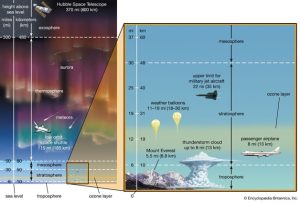
Note: Relative activities occur at various atmospheric layers (Britannica, n.d.)
Source: https://cdn.britannica.com/42/90442-050-6CB42E65/layers-atmosphere-Earth-phenomena-heights.jpg
Types and Shapes of Orbits
As with the previous topic on atmospheric layers, the type of orbit a satellite is in will significantly contribute to the countermeasures or counter-countermeasures employed. The following are critical concepts that will be understood and considered.
As previously stated, this part of the chapter does not perform a deep dive into the mathematics of orbital velocities or the other aspects of orbital mechanics. This will be further discussed in the following chapter(s). However, it is essential to understand that each orbit can have a specific shape and distance. The one selected will vary based on its intended operation/mission and acceptance of that selection’s associated benefits and risks.
Inclination: Orbital inclination is identified as the amount of angle or tilt. In the case of a satellite orbiting the earth, that angle is referenced as the angle between the satellite’s orbit and the planet’s equator. Generally, such orbits are referenced as near equatorial, polar, or inclined.
Figure 2-2 Orbital Inclination

Note: The same concept applies to retro rotation, which is the satellite rotating in the reverse direction of the planet.
Source: https://www.britannica.com/science/spaceflight
Shape: There are two general orbital shapes, circular and elliptical. Circular orbits are a fixed distance from the earth and are designated as LEO, MEO, and HEO, which are described in detail in the next section. This orbit is usually performed for geosynchronous orbits in which the satellite maintains a fixed earth position. The other orbital shape is elliptical and is defined by two different points regarding the planet being orbited. The closest point is the perigee, and the furthest is the apogee, which will play a role in any attack or asset protection determinations.
Figure 2-3 Orbital Shape

Source: https://www.britannica.com/science/spaceflight
Orbits by Attitude
Talk about the types of orbits and the significance of each. Also, how this aligns with the orbital inclination and shapes:
LEO or Low-Earth Orbit satellites can employ an elliptical or circular orbital shape, as illustrated in Figure 2-3. LEO orbits are mainly in the altitude range of 155 to 1243 miles (250–2000 km). Satellites in this orbit class complete an earth orbit in approximately 84-127 minutes, depending on the altitude. This low altitude requires a faster orbital speed to maintain the balance between centrifugal force and gravity, which is approximately 17,500 mph or 7.8 km/s. At this speed, the International Space Station (ISS) will circle the earth 16 times daily at 90 minutes intervals ( European Space Agency, n.d.). Examples of satellites in this orbit would be Remote Sensing Satellites such as weather, terrestrial surface mapping, climate change, oceanographic observation/monitoring, spy/surveillance, and Hubble and the International Space Station.
Table 2-1 Advantages and disadvantages for satellites in GEO orbit
The following table list some advantages and disadvantages for satellites in GEO orbit:
| Advantages: | |
| 1. Small, less expensive launch vehicles can push the satellite into an LEO orbit.
2. The quicker orbit speed makes for a faster moving target in the event Anti-Satellite Weapons (ASW) were deployed against it. For perspective, a typical 55 grain NATO 5.56x45mm bullet, used in AR15 assault rifles, travels at approximately 3,250 ft/s (991 m/s) (Wikipedia, 2001) or a little over 3,500 mph compared to a satellite traveling at about 17,500 mph. 3. The lower orbit allows for better clarity for imaging and surveillance 4. Lower proximity to the surface reduces communications latency between the satellite and ground station, which will be in the low range of 5 to 10 msec. 5. Low-earth orbits (LEOs) can also be effectively used for satellite communications. LEO orbits range from 250 to 1000 miles, and signal time delays are only 5 to 10 msec. This advantage also includes reduced power consumption for the communication links, with an average power usage of .5W (Perez, 1988).
|
|
| Disadvantages: | |
| 1. The low but fast orbit limits the satellite to a small field of view compared to other orbits. It has a short duration over any given geographical location of about 5-20 minutes per orbit. Requires a network or constellation of satellites working together to provide adequate coverage. Also, the ground station and satellite must use highly directional antennas to conserve power consumption.
2. The LEO orbit has become congested with space debris from other satellites and rocket boosters from previous launches, which can result in high-velocity impacts. 3. The low orbit would make an ASW assault more feasible and allow multiple attack attempts since it will be more difficult for the protection agency to re-task the satellite to a safe position due to orbital congestion. 4. Due to orbital decay resulting from atmospheric drag, the satellites typically have a 7–10-year lifespan, although some were extended due to the refueling/repair work from various Space Suttle missions. |
MEO or Medium Earth Orbit satellites operate in the boundary between 1,243 – 22,235 miles (2,000-35,768 km). Their orbital time can be between 2 hours at the lower altitudes and just under 24 hours at the higher altitudes, but in either case, the satellite will cross two points on the equator at the same time interval per orbit. Generally, t, the satellites employ a near-circular, semi-synchronous, low eccentricity orbit or use an elliptical pattern. A standard elliptical orbit is the Molniya orbit, a combination of a high inclination and high eccentricity. The Russians invented this orbit, which provides a wider viewing area and a more extended viewing period when approaching and leaving the apogee and moves quickly when approaching the perigee. These orbits usually contain satellites for GPS, navigation, communication (Sirius and XM radio), cellular, internet, and surveillance.
Figure 2-4 Molniya orbit
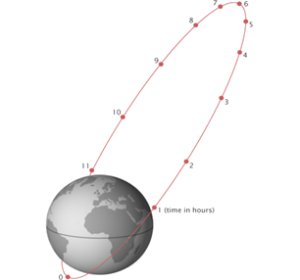
Note: The Molniya orbit is a preferred method when observing areas of high latitudes and will spend approximately 2/3rd of its orbit over one hemisphere (NASA, 2009). There is also a Tundra orbit which is well suited for communications satellites.
Source: https://earthobservatory.nasa.gov/features/OrbitsCatalog
Table 2-2 Advantages and disadvantages for satellites in LEO orbit
The following table list some advantages and disadvantages for satellites in LEO orbit:
| Advantages: | |
| 1. Launched into higher altitudes than LEO satellites and are subject to less orbit decay. This typically increases their expected lifespan to approximately 10 – 15 years.
2. Have an improved communication time delay compared to higher orbit satellites (40 ms vs. 120 ms for GEO orbits) 3. Slower rotation and more time over viewing area and requiring fewer satellites in a constellation/network for global coverage. |
|
| Disadvantages: | |
| 1. Requires a more powerful launch vehicle to obtain higher orbit
2. Slower speed can make it a more assessable target for Anti-Satellite Weapons (ASW) systems. 3. Require a more robust power system for transmission. |
Source: Information sourced from (RF Wireless World, n.d.)
GEO or Geosynchronous/Geostationary Earth Orbit is generally accepted to range from 22,236 – 26,199 miles (22,236 – 42,164 km). Their primary feature is their ability to remain over a geographic area due to their 24-hour orbital rotating of 23 hours, 56 minutes, and 4.1 seconds matching the earth’s rotation. Maintaining the orbital speed and distance requires some station-keeping and, when retired, are placed in a higher orbit. Satellites generally found in this orbit are communications, meteorology, and navigation. Because of their extreme distance, it is possible to provide global coverage with as few as three satellites (Wikipedia, 2001). This is coveted international real estate since only a limited number of satellites can exist here due to spacing and RF interference requirements.
Table 2-3 Advantages and disadvantages for satellites in GEO orbit
The following table list some advantages and disadvantages for satellites in GEO orbit:
| Advantages: | |
| 1. They are less affected by atmospheric drag that results in orbit decay, extending their life expectancy by 15 years.
2. Excellent for TV and radio broadcasts and weather forecasting. 3. Ground stations do not need to hand off communications to other stations because they remain within line of sight; footprints can cover approximately 1/3 of the earth’s surface. 4. High altitude has less debris and will take ASWs longer to get to. |
|
| Disadvantages: | |
| 1. Solar and lunar forces will cause satellite deviation from the planned orbit requiring the use of thrusters for adjustments.
2. Communication delays make real-time or interactive impractical. 3. Slower moving and stationary orbit make for a more vulnerable ASW target. 4. Expensive to maintain due to increased weight, need for more powerful transmitters, and fuel to maintain orbit. |
Figure 2-5 Orbital Altitude

Note: The same concept applies to retro rotation, which is the satellite rotating in the reverse direction of the planet.
Source: https://www.britannica.com/science/spaceflight
HEO or High Earth Orbit and High Elliptical Orbit are essentially any orbits above 22,235 miles (35,768 km). Satellites in this zone will have orbital periods greater than 24 hours and appear to move backward or retrograde, although they are moving forward. Satellites in this orbit require huge boosters and usually require a transition orbit to obtain such altitudes. These devices are typically large and require significant power demands for signal transmission. Satellites in this orbit have been related to the military, deep space astronomy, nuclear monitoring/compliance, and deep space research.
Figure 2-6 High Altitude Orbits

Note: The image is not to scale with HEO tapering off into space approximately halfway to the moon and is a modification of work from Mark Mercer.
Sourced: https://upload.wikimedia.org/wikipedia/commons/b/b8/Orbitalaltitudes.svgt
Table 2-4 Additional Orbital Information

The table provides additional summary information on the previously described orbits.
Adapted from: https://newspaceglobal.com/operational-orbits-advantages-and-disadvantages
Orbital Congestion and Debris
Before discussing actual Anti-Satellite Weapons (AWS) and their systems, a final and critical topic is the vast number of objects that encircle the earth and who owns them. As stated at the beginning of the chapter, from 1957 to now, the heavens have gone from 1 artificial satellite to approximately 4,852 as of 12/31/21. This distribution of this number is illustrated in the following table.
Table 2-5 4,852 as of 12/31/21
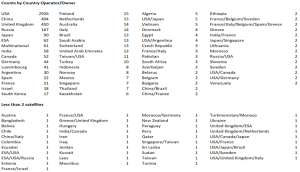
Sourced from: https://www.ucsusa.org/media/11491
The location, identification/owner, and tracking of satellites and debris are essential to ensure the safe placement or movement of new or existing satellites and protect the space assets of allies. The below displays the number of satellites in space as of 12/31/22-That count has grown during this writing.
Figure 2-7 Satellite By Country with Purpose & Orbit
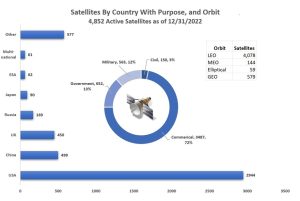
Note: This contains only known active satellites and does not account for any that may have been retired or space debris.
Adapted from: https://www.ucsusa.org/media/11491
Satellite image from: https://findicons.com/icon/28535/satellite#
The number of active satellites dwarfs the number of actual decommissioned satellites and other space debris currently in orbit. It is essential to determine whose and what objects are encircling the earth when discussing Anti-Satellite Weapons (AWS) systems and understand that space debris has accumulated over sixty decades of defuncted satellites, experiments, and components from launch vehicles. This issue is of such concern that the DoD and NASA work jointly using the Space Surveillance Network (SSN), optical telescopes, DebriSat, Haystack X-Band Radar, and Long Duration Exposure Facility (LDEF) to track debris in the known orbital planes (NASA Orbital Debris Program Office, n.d.). Similarly, the European Space Agency, whose Space Debris Office in the European Space Operations Center (ESOC)is located in Darmstadt, Germany, also tracks an orbital collision risk assessment team. (European Space Agency, n.d.) It is important to note that contrary to popular belief, not all space debris is cataloged and tracked; statistical analysis and modeling are used for objects smaller than 10 centimeters or 4 inches (NASA, 2021). According to measurements from the ESA, as of July 11, 2022, the below satellite and space debris data has been observed:
Table 2-6 Space Satellite & Space Debris Data
| Activity/Event | Count |
| Satellite Data | |
| · Satellites placed in orbit via rocket launches | 13,320 |
| · Satellites in orbit | 8,580 |
| · Functioning satellites in orbit (maybe the end of life, out of fuel, or placed in graveyard orbit but electronics still working) | 6,100 |
| · Debris is regularly tracked and cataloged by SSN. | 31,740 |
| · Estimated events (explosions, collisions, etc.) resulting in fragmentation. | 630 |
| General Debris Data | |
| · Debris greater than 10cm (4 inches) | 36,500 |
| · Debris > 1cm (approx. size of #2 pencil) but less than 10 cm | 1,000,000 |
| · Debris > 1 mm but less than 1 cm | 130,000,000 |
Sourced from: (European Space Agency, 2022)
As previously noted in the LEO, orbital speeds are very fast, and as an example, a NATO 5.56mm bullet travels at approximately 3,260 f/s or about one km/s. Debris from a satellite, including paint chips, can travel between 4-8 km/s or roughly 13,123-26,246 f/s. These velocities translate to small objects containing high amounts of kinetic energy, sufficient to destroy a functioning satellite on impact.
Figure 2-8 Partial view of satellites and space debris in orbit from a global and continental view perspective
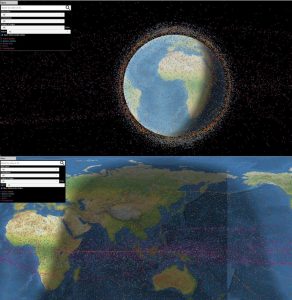
Note: Due to cropping, images do not capture full orbital tracks for outer orbits.
Source: Realtime satellite and debris tracking (AstriaGraph, 2022). https://astria.tacc.utexas.edu/AstriaGraph/
The weaponization of Space and Methods of Satellite Attrition
Due to the vastness of the topic and out of respect for chapter length, an in-depth review of ground-based Direct Energy Weapons (DEW) will not be explored at this time. However, it is one of the multiple methods of satellite eradication.
Of the many methods of obtaining kill proximity to a satellite, there are only a few principles, Direct Accent or Hit-to-Kill (DA-ASAT) and Co-orbital (Co-ASAT). These two principles allow for deploying such methods as Direct Energy Weapons, Anti-satellite missiles, killer satellites, and the use of natural and artificial debris. The following will provide examples of direct and indirect attacks that could be employed to destroy a satellite or constellation of satellites. It is also critical to understand the existence of space debris caused by numerous ASAT tests executed since the 1960s and the role it can play in the intentional destruction of satellite assets.
Initially, weapons testing in space was conducted by the United States and Russia. This has since expanded to include China and India.
Table 2-7 Space Debris because of ASAT Tests
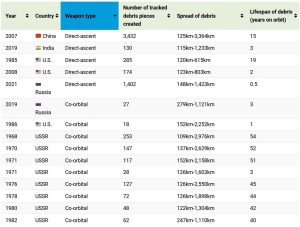
Sourced from: https://www.visualcapitalist.com/sp/anti-satellite-weapons/ (Bhutada & Smith, 2022)
Debris field disruption: Each orbital level has various amounts of debris. LEO is not only very saturated but also has the fastest traveling objects. A collision of any type will cause a cascade of collisions, also known as the Kessler Syndrome. In short, the concept is based on the collision of two or more objects. Although the physic associated with the laws of collisions and motion is outside the study of this text, it is essential to understand that objects traveling at such high velocities, even objects of negligible mass, will have high-energy impact collisions that will result in the creation of smaller objects moving in opposite directions with equal force. These smaller objects will collide with other debris, and the crashes will continue resulting in a debris storm. As previously discussed, the LEO orbit has numerous entities, including functional satellites and the ISS (International Space Station). There have been noted satellite collisions, with the first known collision occurring in 1991 when Russia’s Cosmos 1934 was struck by a piece of Cosmos 926. Then, in 1996, France’s Cerise satellite was hit by an Ariane 4 rocket fragment. In 2005 a US upper stage was hit by a piece of a Chinese rocket’s third stage. In 2009 an Iridium satellite collided with Russia’s Cosmos-2251”, with devastating results (European Space Agency, n.d.).
Left Figure 2-9 / Hits on Satellites / Right Figure 2-10
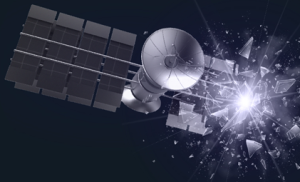
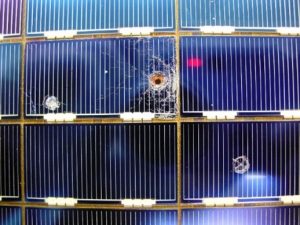
Right Source: Source: https://space-env.esa.int/madweb/
Left, altered from: https://www.visualcapitalist.com/sp/anti-satellite-weapons/ (Bhutada & Smith, 2022)
Debris weaponization needs to be a concern of any nation owning or operating a satellite. The importance of satellites and their ability to provide Realtime intelligence to military troops is well known. Some countries may not have the technical capabilities of their adversaries but wish to disrupt the ability to collect SATINT or disrupt their communications, command, and control capabilities to ground, naval, and aviation forces to level the playing field. Such a country may be short on resources to perform satellite management or even the technology to track and target an object in orbit. However, they may be able to use the debris field to destroy their opponent’s space assets and cause the desired disruption. For example, North Korea has developed and test-launched the Hwasong-12 ballistic missile. This rocket is reported to have reached an altitude of 2,111 km or 1,311 miles. As previously studied, the LEO orbit is generally below 2,000 km. (Center for Strategic and International Studies, 2022). This attitude provides the capability to deliver a payload anywhere within the LEO and lower portions of the MEO orbit. As discussed, tracking, and striking a fast-moving object is a complex operation. However, delivery of a high explosive detonation does not contain near the level of sophistication but will render similar results. Such a scenario would begin a chain of reactions in which space debris would become an ever-growing cloud of shrapnel that would increase with the destruction of other objects in the ongoing collisions. This could eliminate observation, monitoring, and communications satellites for virtually every country. The increasing proliferation of surplus missile boosters makes such scenarios a viable threat vector.
Figure 2-11 Various ASTAT Tests and debris creation

Altered from: https://www.visualcapitalist.com/sp/anti-satellite-weapons/ (Bhutada & Smith, 2022).
Surface/Air to Space missiles (DA-ASAT, non-DEW): After the successful launch of Sputnik, The US quickly became aware that Russia had established space superiorly and could spy on US installations. In addition, it was conceived that the Russians would begin to deploy nuclear projects into orbit, providing a first-strike capability. The initial US response in 1958 was developing and testing the ASAT weapon Bold Orion or (WS-199B), an air-launched missile. Testing and development continued until a successful near interception test was performed in LEO, where the missile came within 4 miles (6.4 km) of the Explorer 6 satellite in October of 1959 (Pike, 2016). This was countered by the Russians in 1960 with a Co-Orbital device, “Dubbed Istrebitel Sputnikov (for the Satellite Destroyer) …” (Zak, 2013).
Figure 2-12 First, ASAT weapons used by US and Russia

Right is the Bold Orion (WS-199B) 1959. Source: https://www.globalsecurity.org/space/systems/bold-orion.htm
left is the Istrebitel Sputnikov. 1960. Source: https: //www.jejaktapak.com/2015/09/06/istrebitel-sputnikov-pemburu-dan-pembunuh-satelit/
From the 1950s to the early 1970, the tactical approach of choice was the use of nuclear warheads and high-explosive warheads for the attrition of enemy satellite assets. In 1963, the US, Soviet Union, and Great Britain signed the Limited Nuclear Test Ban Treaty, understanding that any such explosion could cause collateral damage to both sides and allies. It should be noted that this treaty did not cover the use of other kinetic-type weapons. By the 1970s, tactics changed, and research began using Kinetic Kill weapons which would strike a target with extreme force. However, the force is such that targets are reduced to thousands of smaller pieces of debris. This was proven out in a few relatively recent events:
2007 China destroyed its old weather satellite (Keck, 2019).
2008 US shoots down its spy satellite in low orbit (Oberg, 2021).
In 2021 Russia shot down its satellite (Litovkin, 2021).
Each of these satellites created large volumes of debris, with the 2021 event causing personnel on the ISS to shelter in place (Mogg, 2021) for multiple orbits until the debris field was no longer considered a danger. However, the debris will remain in orbit for decades, as outlined in table 2-7.
An overview of the Kinetic Kill Weapon/Warhead (KKW) can be illustrated by the SM-3 missile, which is a DA-ASAT hit-to-kill system that releases an independent 21-inch (530mm), Lightweight Exo-Atmospheric interceptor kill vehicle that will close on the target at approximately 10km/s (22,000 mph) (GAO, 2011).
Figure 2-13 AEGIS BMD SM-3 Missile Profile
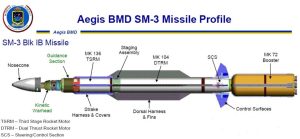
Adapted from: https://missiledefenseadvocacy.org/defense-systems/standard-missile-3-sm-3/
At this velocity, the impact would be equivalent to “…130 megajoules of kinetic energy, or the equivalent of a 10-ton truck traveling at 600 miles per hour.” (Raytheon, 2007). For perspective, that would be roughly equivalent to a standard school bus traveling near the top speed of a 747 commercial jet crashing into an object. The result will be the pulverization of the target and the creation of additional high-velocity space debris.
DA-ASAT challenges include previously identified obstacles associated with LEO. First and foremost, the DA-ASAT will require a propulsion system with sufficient force to obtain attitude. Although some missiles can reach low to middle LEO, fewer can reach higher regions. If the attitude barrier is overcome, objects in this orbit travel at high velocities, making it very difficult to perform target identification, tracking, and acquisition. This will leave little time for developing a firing solution before the target passes from range. Although there are numerous claims of success, failed attempts are seldom discussed for obvious reasons. A consideration continuously mentioned is the ever-increasing space debris. Any DA-ASAT must navigate past debris traveling at velocities in the “high” hypersonic speed spectrum and have superior target identification facilities as part of its instrumentation.
It is important to note that the missile system illustrated is only one of many designs in which each company, country, and their associated engineers, will have varying methods. Still, the general concepts and principles will be virtually identical regardless of design differences.
Figure 2-14 Other types of ASATs and their countries
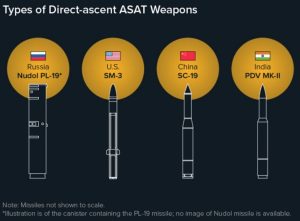
Source: https://www.visualcapitalist.com/sp/anti-satellite-weapons/ (Bhutada & Smith, 2022)
Co-Orbital (CO-ASAT): These are weapon systems that are placed in orbit with the intent of maneuvering close to a target satellite from its orbital parking plane and can maneuver to the higher or lower plane of the target satellite and destroy it via various means. Such ASAT devices can have a dual objective. Being disguised as weather, communications, or having other non-imposing intentions, may allow them to remain in orbit without attracting attention to their disguised mission until called to action. This ASAT class could also chase down another orbital body over multiple orbits until it is close enough to perform its kill protocol. Such maneuvering has been observed by activities from Kosmos-2543 to match the orbit of Kosmos-2535 for a rendezvous and was able to change fore and aft orbital positions (Chabot, 2019). As referenced in table 2-7, Russia/USSR has performed nine co-orbital tests since 1982 and the US 1. Before 1982 there were 17 documented Russia/USSR co-orbital-related tests confirmed from 1963-1981 (The Space Review, n.d.). Due to state secrets, it is difficult to know how many co-orbital satellite activities related to eliminating adversary assets have occurred.
The following are examples of co-orbital actions that can occur; some have been demonstrated.
Figure 2-15 Co-orbital-based weapon types
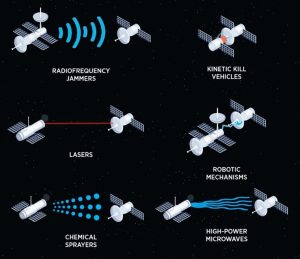
Source: https://www.dia.mil/Portals/110/Documents/News/Military_Power_Publications/Challenges_Security_Space_2022-pdf
Direct collision or Kinetic Kill Vehicles are based on techniques discussed in our exploration of DA-ASAT and how high-velocity impacts can cause extensive damage to a targeted satellite. The concept is the same, except the kill vehicle is an orbital device that can transition orbital planes in pursuit of a target.
Radiofrequency Jammers would permit an attacking satellite to maneuver near another satellite and jam its sending and receiving singles. An attacking satellite could align its orbit close enough to the target satellite to perform cognitive jamming via spectrum sensing. This technology will allow the attacker to sense the transmit-receive frequencies used by the target and use a “detect and jam” strategy. Even as the target satellite attempts to perform anti-jamming mitigation, the attacking satellite could continue its spectrum analysis via techniques such as detection sliding energy window analysis. (Tianq, Pham, & Blasch, 2012) Jamming may only need to exist for a short period to cause a disruption, especially if the target is in LEO.
Microwave bombardment has become a feasible attack method for satellite-to-satellite conflicts, as proven with high-power microwave (HPM) experiments on electronic circuits using narrow-band and ultra-wide-band (UWB) pulsed radiation to damage the electronic circuitry of the target (SAE Media Group, 2008). A microwave-capable ASAT maneuvering near a target could emit microwaves creating an energy transference that would build up additional voltage within the target satellite. This would generate thousands of volts, causing the target’s electronics conductors to build up voltage and heat, which would semiconductors, processors, and even melt critical components. Space research has proven this using Photovoltaic Radio-frequency Antenna Module (PRAM) technology. “PRAM converts sunlight for microwave power transmission.” (Trevithick, 2020) to provide power.
Cyber-attacks are not limited to terrestrial devices. (Nichols, et al., 2022) Satellites will have similar vulnerabilities. Satellites receive communication from earth stations and, in many cases, multiple earth stations, all of which will require authentication. This implies the need for a communication and security protocol to serve the receival of the request, acknowledgment, and handshaking necessary for passing credentials. This can be subject to a DoS (Denial of Service) attack where the satellite could become overwhelmed attempting to service the request and unable to authenticate with the legitimate source, affecting its ability to receive instructions from its base. Depending on the orbit and satellite’s velocity, it may pass its communication window with a particular ground station and must proceed to the next. As discussed in orbit advantages and disadvantages, LEO orbits require less power to communicate with the ground and usually have smaller antennas and less powerful transmitters. Another satellite or constellation of satellites in orbit could potentially provide more focused signaling and begin an attack before the target satellite enters its communication window with the ground and cause disruption. This is one of the numerous possible cyber-attacks that could be performed. A similar cyber situation occurred where hackers acquired control of a decommissioned satellite and broadcasted their conference via the Anik F1R satellite (Paganini, 2022).
Figure 2-16 Illustration of a practical satellite hack scenario

Source: Arstechnica.com via https://universemagazine.com/en/how-to-destroy-a-satellite-without-firing-a-single-shot/
Laser weaponry for the use of co-orbiting attack satellites, lasers may not be a practical solution at this point due to the amount of power necessary to burn through the materials of a target satellite effectively. However, much work is underway to create more powerful lasers that require less power consumption. It should also be noted that additional energy would not be lost due to distance spreading, atmospheric ionization, atmospheric dispersion, and refraction as a ground-to-space attack. However, the technology does exist to use laser light to blind a target. This could be useful in anti-surveillance and detection, especially in the detection of hypersonic missile launches, which have a less pronounced launch signature than the standard ICBM.
Chemical sprayers would be a more insidious method of attack where the target would be sprayed with a chemical agent that would cause corrosion of the satellite surface and eventually compromise the system, which is already under stress due to thermal changes and forces associated with high-velocity travel. “Thermal stresses occur in the LEO orbit on the outer surface of satellites due to periodic in and out of the sunshade during orbiting. At LEO, this happens every 90 minutes and is roughly +100°C to -100°C. This temperature change causes thermal stresses in materials, and the difference in CTE will cause spalling of the oxide layer present on metal surfaces and results in constantly exposing fresh material to the atomic oxygen environment.” (European Space Agency, n.d.). Such a dispersal of corrosive materials could reduce the efficiency of solar panels and their components and eventually comprise the structural integrity of the satellite.
Satellite robotic mechanisms have advanced exponentially over the past decade with the advancement of cube satellites, cheaper transport, improved robotic arm, camera systems, faster computing power, advanced software for accurate target identification and acquisition, and improved autonomous response. These improvements are now enabling devices to intercept and capture fast-moving objects. Recently, the US, England, and China have embarked on several experiments testing this technology under the guise of space debris removal to clean up the lower orbits. These countries have performed technological demonstrations giving each other weighty reasons for concern because the same technology used for debris removal can do the same to opposition assets. The following are known efforts that reflect the technology being tested.
- In March 2021, a Japanese firm Astroscale Holdings Inc. launched a test mission with two satellites, “…a servicer designed to safely remove debris from orbit and a client satellite that serves as a piece of replica debris… this pioneering mission to demonstrate the technologies and capabilities necessary for debris capture and removal. The servicer satellite will release and dock magnetically with the client satellite in the first three complex demonstrations. Following this demonstration of non-tumbling capture, ELSA-d will perform two additional demonstrations: one to capture the client while it is tumbling, and one to lose deliberately, re-locate, approach, and re-capture the client from far-range.” (Howlett, 2021), intending to pull it to a lower altitude where it will burn up in the atmosphere.
Figure 2-17 Image of Astroscale’s ELSA-d with the “chaser” and “target” vehicle
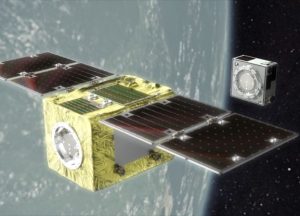
Source: https://astroscale.com/astroscale-statement-on-our-elsa-d-demonstration/
- On January 2022, China’s Shijian-21 (SJ-21) satellite was observed leaving its orbit and approaching the DeiDou-2 G2- It was later observed attaching to the G2 and throwing it into what is known as a “graveyard” orbit, where dysfunctional satellites are typically relocated, except under their power, to be retired. After performing this act, the SJ-21 returned to its regular GEO orbit. There are concerns that this was not only a test to remove debris but also to demonstrate the ability to push a satellite into an unwanted atmospheric re-entry (Hitchens, 2022).
- “RemoveDebris” is a European consortium satellite operated by Surrey Satellite Technology Ltd. Launched in April 2018, its mission was to:
- Flight a capturable object.
- Track and capture with net technology.
- Test a VBN LiDAR camera system for ranging.
- Perform accuracy tests for harpoon capture.
- Drag sail deployment for expedited orbit decay.
The mission accomplished its stated objectives (Aglietti, et al., 2019).
Figure 2-18 Visual of the mission profile for the RemoveDebris mission
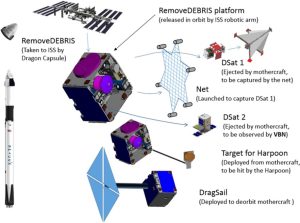
Source: https://www.cambridge.org/core/journals/aeronautical-journal/article/removedebris-an-inorbit-demonstration-of-technologies-for-the-removal-of-space-debris/88B966915E7A3BD6F0B047A38FF713D2
Figure 2-19 Photo and cutaway views of the RemoveDebris cube satellite
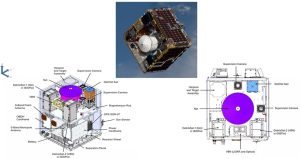
Top image source: https://www.nasa.gov/mission_pages/station/research/experiments/explorer/Investigation.html#id=7350
Bottom images source: https://www.surrey.ac.uk/surrey-space-centre/missions/removedebris
Of the many ASAT technologies being explored, there seems to be a trend towards solutions that would minimize collateral damage. Other than Kinetic Kill Weapons, the other co-orbital methods target a specific asset and do not disturb the orbiting debris field, which could also impose uncontrolled collateral damage on the attacking nations’ assets.
Orbiting Hypersonic Missile Platforms
In addition to weather, communication, and spy satellites, there are orbiting platforms. The diagram below identifies 15 different platforms across 11 different types.
Figure 2-20 Sample of current and past orbital platforms
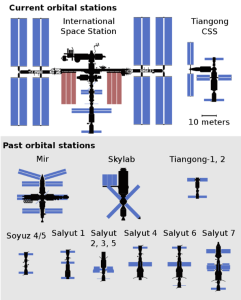
Source: https://upload.wikimedia.org/wikipedia/commons/thumb/7/77/Space_station_size_comparison.svg/836px-Space_station_size_comparison.svg.png
In 1963, 112 countries signed the Outer Space Treaty, which essentially bands the use of nuclear weapons in space. “Key provisions of the Outer Space Treaty include prohibiting nuclear weapons in space; limiting the use of the Moon and all other celestial bodies to peaceful purposes; establishing that space shall be freely explored and used by all nations; and precluding any country from claiming sovereignty over outer space or any celestial body. Although it forbids establishing military bases, testing weapons, and conducting military maneuvers on celestial bodies, the treaty does not expressly ban all military activities in space, nor the establishment of military space forces or the placement of conventional weapons in space.” (Wikipedia, 2003). The specific declaration against nuclear weapons has left the door open for other possible systems, such as the launching of Kinetic Energy systems that do not need a nuclear warhead since their hypersonic velocities will produce devastating results by releasing the equivalent of kilotons of TNT (depending on weight, density, and final impact speed).
A known weapons platform that has been part of the escalating arms race has been the development of hypersonic weapons. A quick recap from book 6, these are vehicles traveling at speeds greater than Mach 5 (>3,806 mph) and attitudes below 90K (295,276 ft). Most objects in LEO orbit travel at velocities of 17,500 mph, and these speeds are known as high-hypersonic, ranging from Mach 10-25. Some Apollo Command Modules (CM) were recorded traveling at reentry velocities at Mach 36 (Smithsonian National Air and Space Museum, n.d.).
In general, there are two types or classes of Hypersonic Missiles. The first being of the Cruise Missile type also referred to as Hypersonic Cruise Missile (HCM), which maintains speed via a SCRAM propulsion system, and the Hypersonic Glide Vehicle (HGV), which uses the forces of gravity and aerial dynamics to obtain its speed and stability.
Figure 2-21 Categories of Hypersonic missiles
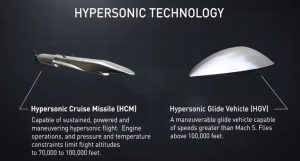
Source: The RAND Corporation (Speier, Nacouzi, Lee, & Moore, 2017)
The focus of this topic will be on the HGV and how it would be applied as a space-based attack vector.
Currently, there are limited ways to detect the launch or deployment of hypersonic missiles. The standard defense strategy, since the cold war era, has focused on detecting ICBM launches and interception. Hypersonic technology has become a game changer in the OODA-loop decision strategy process of Observe, Orient, Decide and Act (Devost & Courley, 2022). The process is impacted because the observation cycle is delayed, which is the start of the process. It should be noted that most early warning technology is optimized to the infrared signature of an ICBM surface or naval launch. This reduction in identification then compresses the time available for the other processes, including the ability to orient. The decrease further shortens the time the under-siege entity needs to act because the devices are so fast. For example, if we were to use the below table, extracted from Chapter 12 of Book 6 on Hypersonic weapons,
Table 2-8 Speed, time, and distance comparisons at various Mach speeds from 1-30 and times to cover 1000 miles
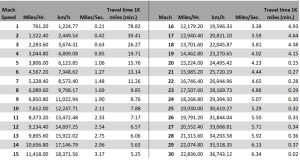
Source: (Nichols, et al., 2022)
It indicates how fast such weapons can move. It is not impractical for an HGV to move around the upper atmosphere over Mach 23 and about the lower altitudes at Mach 10, which can cover 1000 miles in under eight minutes.
The trajectory of HGV may resemble the diagram in a typical launch-to-guide scenario.
Figure 2-22 Launch – to – Glide Scenario
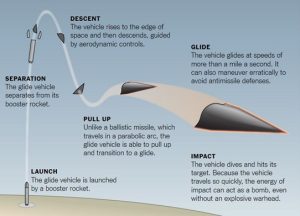
Source: http://www.space4peace.org/articles/race_for_new_nukes.htm
In such a scenario, there is the ability to observe the infrared signature of the missile booster. In addition, the targets of the HGV will be less due to the height constraint of the booster. In a space-drop deployment scenario, the height restriction will be removed. Also, there will not be an infrared heat signature from the ground for observation satellites to detect and report and depending on the time of day; it may be challenging to obtain early confirmation that an HGV has been launched and started its re-entry trajectory, which may resemble an atmospheric skip as displayed in the below diagram.
Figure 2-23 HGV is capable of skipping across the atmosphere to engage any target on the globe
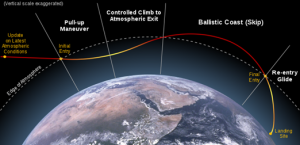
Source: https://alphadefense.in/hypersonic-technology-and-its-future/
This will provide the HGV stealth because it can be dropped from a different global location and begin its targeting activities. Once entering the atmosphere, it will have the ability to maneuver, and because of its high altitude, it can confuse enemy tracking as to the actual target. Also, if the primary target is no longer available, multiple alternates can be selected. It should be noted that the options are fewer as the HGV gets lower. At a designated point, the HGV will drop on its target with maximum velocity to unleash as much kinetic energy and destruction as possible.
Figure 2-24 HGV will have more targeting options available
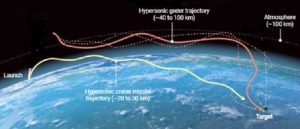
Source: Modified from https://alphadefense.in/hypersonic-technology-and-its-future/
Despite treaties and national agreements, the use of hypersonic weapons being launched from space is a consideration that must be pondered. The ability to have a first strike capability is too much of an enticement for nations that have demonstrated a tradition of breaking treaties or violating established norms and rules of engagement. Any country that would ignore such may do so at its demise.
Summary
In this chapter, we have studied atmospheric and orbital impacts associated with the advantages and disadvantages of orbiting or attacking a satellite. We have also briefly explored the history and evolution of Anti-Satellite (ASAT) technology and the earth-covering debris it has created. This reading has also covered various methods to kill satellites through intentional and unintentional means and the ongoing efforts of some countries to obtain and maintain space superiority. This chapter’s concepts and principles should provide a foundation for the upcoming reading.
References
European Space Agency. (n.d.). Low earth orbit. Retrieved from ESA.int: https://www.esa.int/ESA_Multimedia/Images/2020/03/Low_Earth_orbit
Aglietti, S., Taylor, B., Fellowes, S., Ainley, S., Tye, D., Cox, C., & Steyn, W. H. (2019, November 26). RemoveDEBRIS: An in-orbit demonstration of technologies for the removal of space debris. Retrieved from cambridge.org: https://www.cambridge.org/core/journals/aeronautical-journal/article/removedebris-an-inorbit-demonstration-of-technologies-for-the-removal-of-space-debris/88B966915E7A3BD6F0B047A38FF713D2
AstriaGraph. (2022, August 14). Realtime Satellite and Debris Map. Retrieved August 14, 2022, from astria.tacc.utexas.edu: https://astria.tacc.utexas.edu/AstriaGraph/
Bhutada, G., & Smith, M. (2022, June 14). Anti-Satellite Weapons: Threatening the Future of Space Activities. Retrieved from visualcapitalist.com: https://www.visualcapitalist.com/sp/anti-satellite-weapons/
Britannica. (n.d.). Atmosphere Vertical Structure. Encyclopedia Britannica, Inc.
Center for Strategic and International Studies. (2022, May 20). Hwasong-12 (KN-17). Retrieved from missilethreat.csis.org: https://missilethreat.csis.org/missile/hwasong-12/
Chabot, A. (2019, November). Soyuz-2-1v launches a possible military inspector satellite. Retrieved from russianspacewab.com: http://www.russianspaceweb.com/cosmos-2542.html
Devost, M., & Courley, B. (2022, August 23). The OODA loop explained: The real story about the ultimate model for decision-making in competitive environments. Retrieved from oodaloop.com: https://www.oodaloop.com/the-ooda-loop-explained-the-real-story-about-the-ultimate-model-for-decision-making-in-competitive-environments/
Dickson, P. (2001). Sputnik the shock of the century. New York: Walker Publishing Company, Inc.
Dryden Flight Research Center. (n.d.). x-15 fact sheet. Dryden Flight Research Center.
European Space Agency. (2022, July 11). Space debris by the numbers. Retrieved July 14, 2022, from esa.int: https://www.esa.int/Space_Safety/Space_Debris/Space_debris_by_the_numbers
European Space Agency. (n.d.). About the space debris office. Retrieved from esa.gov: https://www.esa.int/Space_Safety/Space_Debris/About_the_Space_Debris_Office
European Space Agency. (n.d.). Corrosion in space. Retrieved from esmat.esa.int: http://esmat.esa.int/Publications/Published_papers/Corrosion_in_Space
European Space Agency. (n.d.). Space smash: Simulating when satellites collide. Retrieved from esa.int: https://www.esa.int/Enabling_Support/Preparing_for_the_Future/Discovery_and_Preparation/Space_smash_simulating_when_satellites_collide
GAO. (2011, March). Missile Defense: Actions Needed to Improve Transparency and Accountability. Retrieved from goa.gov: https://www.gao.gov/assets/gao-11-372.pdf
Hitchens, T. (2022, January 27). China’s SJ-21 ‘tugs’ dead satellite out of GEO belt: Trackers. Retrieved from breakingdefense.com: https://breakingdefense.com/2022/01/chinas-sj-21-tugs-dead-satellite-out-of-geo-belt-trackers/
Howlett, A. (2021, June 2). Astroscale celebrates successful launch of ELSA-D. Retrieved from astroscale.com: https://astroscale.com/astroscale-celebrates-successful-launch-of-elsa-d/
Keck, Z. (2019, October 3). How China could win a war against America: Kill the satellites. Retrieved from nationalinterest.org: https://nationalinterest.org/blog/buzz/how-china-could-win-war-against-america-kill-satellites-85176#:~:text=China%20also%20used%20the%20SC-19%20missile%20to%20destroy,tests%2C%20including%20ones%20in%202010%20and%20January%202013
Litovkin, N. (2021, November 16). Why Russia shot down its old satellite and what weapon was used. Retrieved from rbth.com: https://www.rbth.com/science-and-tech/334418-why-russia-shot-down-satellite
Mogg, T. (2021, November 16). Space station emergency caused by cloud of satellite debris. Retrieved from digitaltrends.com: https://www.digitaltrends.com/space/space-station-emergency-caused-by-cloud-of-satellite-debris/
Mostly Missile Defense. (2012). Aegis ballistic missile defense interceptors (SM-3, SM-2 block IV, and SM-6) (May 2, 2012). Mostly Missile Defense.
NASA. (2009, September 4). Catalog of earth satellite orbits. Retrieved from earthobservatory.nasa.gov: https://earthobservatory.nasa.gov/features/OrbitsCatalog
NASA. (2015). What is a satellite? NASA.
NASA. (2021, May 26). Space Debris and Human Spacecraft. Retrieved from nasa.gov: https://orbitaldebris.jsc.nasa.gov/measurements/
NASA Orbital Debris Program Office. (n.d.). Debris Measurements. Retrieved from orbitaldebris.jsc.nasa.gov: https://orbitaldebris.jsc.nasa.gov/measurements/
Nichols, R. K., Sincavage, S., Mumm, H. C., Lonstein, W., Carter, C., Hood, j. p., . . . Slofer, W. (2022, June). DRONE DELIVERY OF CBNRECy – DEW WEAPONS Emerging Threats of Mini-Weapons of Mass Destruction and Disruption ( WMDD). Retrieved from kstatelibraries.pressbooks.pu: https://kstatelibraries.pressbooks.pub/drone-delivery/
Oberg, J. (2021, July 27). U.S. satellite Shootdown: The inside story. Retrieved from sprectrum.ieee.org: https://spectrum.ieee.org/us-satellite-shootdown-the-inside-story
Paganini, P. (2022, August 21). White hat hackers broadcasted talks and hacker movies through a decommissioned satellite. Retrieved from securityaffairs.co: https://securityaffairs.co/wordpress/134637/hacking/hackers-take-control-decommissioned-satellite.html
Perez, R. (1988). Wireless communications design handbook: Terrestrial and mobile interference: Aspects of noise, interference, and environmental concerns. Cambridge: Elsevier.
Pike, J. (2016). Bold Orion weapons system 199 (WS-199B). Retrieved from globalsecurity.org: https://www.globalsecurity.org/space/systems/bold-orion.htm
Raytheon. (2007). Standard Missile-3. Retrieved from raytheon.com: http://www.raytheon.com/products/stellent/groups/public/documents/content/cms01_055769.pdf
RF Wireless World. (n.d.). Advantages of MEO orbit | disadvantages of MEO orbit. Retrieved from rfwireless-world.com: https://www.rfwireless-world.com/Terminology/Advantages-and-Disadvantages-of-MEO-orbit.html
SAE Media Group. (2008, August 1). Effects of high-power microwave pulses on electronic systems. Retrieved from aerodefensetech.com: https://www.aerodefensetech.com/component/content/article/adt/tech-briefs/electronics-and-computers/4871
Smithsonian National Air and Space Museum. (n.d.). Hypersonic flight. Retrieved Aug 26, 2022, from https://airandspace.si.edu/stories/editorial/hypersonic-flight
Speier, R. H., Nacouzi, G., Lee, C., & Moore, R. M. (2017). Hypersonic Missile Nonproliferation Hindering the Spread of a New Class of Weapons. Retrieved August 28, 3019, from rand.org: https://www.rand.org/pubs/research_reports/RR2137.html
The Space Review. (n.d.). Through a glass, darkly: Chinese, American, and Russian anti-satellite testing in space. Retrieved from thespacereview.com: https://www.thespacereview.com/article/2473/2
Tianq, X., Pham, K. D., & Blasch, E. (2012, May). Jamming/Anti-jamming Game with a Cognitive Jammer in Space Communication. Retrieved from researchgate.net: https://www.researchgate.net/publication/258716106_JammingAnti-jamming_Game_with_a_Cognitive_Jammer_in_Space_Communication#:~:text=The%20cognitive%20jammer%20is%20assumed%20to%20have%20powerful,transmitter%20to%20the%20receiver%20over%20the%20communicatio
Trevithick, J. (2020, May 19). X-37B’s power beaming Payload a reminder of potential orbital microwave anti-satellite weapons. Retrieved from thedrive.com: https://www.thedrive.com/the-war-zone/33531/x-37bs-power-beaming-payload-a-reminder-of-potential-orbital-microwave-anti-satellite-weapons
USCUSA. (2021). UCS satellite database. Union of Concerned Scientists.
Wikipedia. (2001, October 1). 5.56×45mm NATO. Retrieved from wikipedia.org: https://en.wikipedia.org/wiki/5.56%C3%9745mm_NATO#:~:text=In%20September%201963%2C%20the.223%20Remington%20cartridge%20was%20officially,and%20a%20chamber%20pressure%20of%2052%2C000%20psi.%20
Wikipedia. (2001, October 1). Geosynchronous satellite. Retrieved from wikipedia.org: https://en.wikipedia.org/wiki/Geosynchronous_satellite
Wikipedia. (2003, May 22). Outer space treaty. Retrieved August 28, 2022, from en.wikipedia.org: https://en.wikipedia.org/wiki/Outer_Space_Treaty
Zak, A. (2013, November 1). The hidden history of the Soviet satellite-killer. Retrieved from popularmechanics: https://www.popularmechanics.com/space/satellites/a9620/the-hidden-history-of-the-soviet-satellite-killer-16108970/

